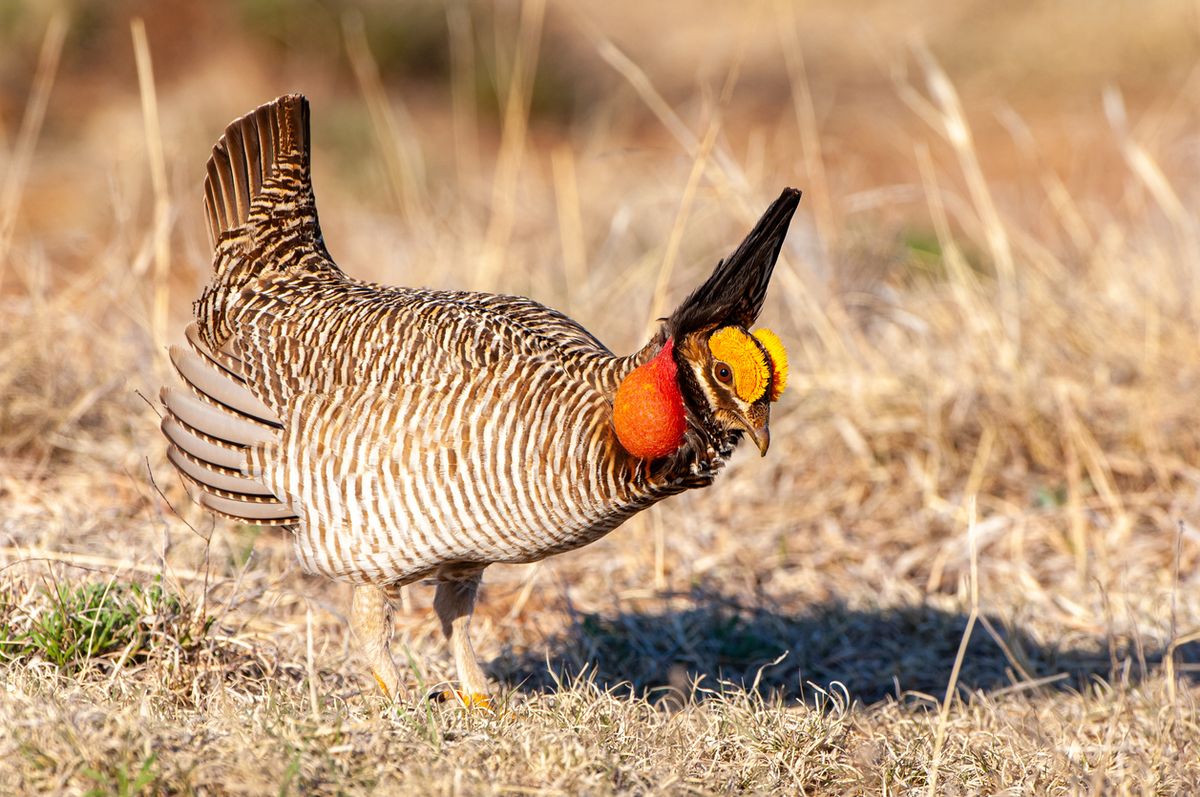A Dancing Bird Finally Gets Some Protection
Writers on the Range

What I remember most about that dark early morning of crouching on the prairie is the rhythmic sound of pounding. It was so loud I wondered if someone had put a microphone near the skinny legs of the dozen birds dancing on the turf. As the sun rose above the horizon in southeastern New Mexico, the male lesser prairie chickens continued their ritual performance, each hoping to entice a female.
They strutted, leaped in the air with feathers spread, and bowed, but the greatest thrill was watching them puff up the garish, red-orange air sacs on either side of their necks.
Concealed in a blind, we watched late into the morning that spring of 1999, until the last birds — members of a rapidly vanishing species — flew off.
I recalled that wonderful day recently, because in late March, after countless lawsuits and scientific opinions, the lesser prairie chicken in New Mexico, Colorado and eastwards finally got what it so desperately needs — federal protection under the Endangered Species Act.
The designation, however, comes 25 long years after the U.S. Fish and Wildlife Service first determined that this magical dancing bird could go the way of the passenger pigeon.
In June 1988, the Service did something seemingly mundane, though it had profound consequences. It relegated the lesser prairie chicken to what might be called endangered species purgatory — making its protection status “warranted but precluded” under the Endangered Species Act. Precluded apparently meant, “We should list the birds but find it impossible to do that.”
For decades, the Fish and Wildlife Service, under pressure from opponents in Congress and powerful industries, has used this designation to delay Endangered Species Act protections for hundreds of species that need an ecological safety net, including the lesser prairie chicken.
The result since 1998 has been predictable: The bird’s numbers have plummeted. In many parts of the West, it has disappeared entirely. Lesser prairie chickens now number about 30,000, less than 2% of what they were in the 19th century when the birds flourished in the hundreds of thousands.
Controversy around granting Endangered Species Act protection for the lesser prairie chicken has mainly been about oil and gas development. Meaningful protection of this bird, whose habitat covers millions of acres across New Mexico, Texas, Colorado, Kansas and Oklahoma, would mean restraint from the oil and gas and agricultural industries. Pump jacks and plows are the greatest threats to prairie chicken survival.
Kansas Republicans, namely Sen. Roger Marshall and Rep. Tracy Mann, have already pressured the Fish and Wildlife Service to delay the date that the listing takes effect. Texas has also filed a lawsuit to block the listing, and Kansas and Oklahoma are threatening to sue. The long struggle to keep the birds alive is far from over.
Fifty years ago, Congress enacted the Endangered Species Act to recognize the importance of endangered and threatened species, citing their “esthetic, ecological, educational, historical, recreational and scientific value to the Nation and its people.” The Act’s vision was remarkable, and Americans are fortunate that the law fought for a half-century ago continues to be fought for today.
I am proud that our nation passed this powerful law to protect the diversity of life. But for our nation’s laws to really mean something, they must be enforced, even when — especially when — opponents are among the most economically and politically powerful industries.
You’d think that identifying a species as “endangered” meant that there was still time to save it. But the prairie chicken, along with its high-profile distant cousin, the sage grouse, is running out of time. The birds need lots of open space, and the new designation only puts some constraints on existing oil and gas operations, while limiting new development.
Later this spring, I intend to return to the prairies near the town of Milnesand, New Mexico, this time with my nine-year-old twins in tow. I can only hope that the birds are still dancing. I also hope that my boys have the opportunity to watch and wonder about why these birds return to woo females at the same place each spring, and what we, as a society, must do to ensure that the dance continues.
